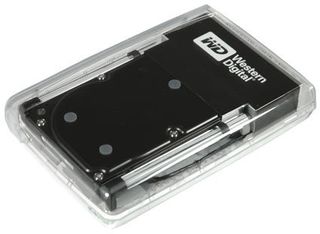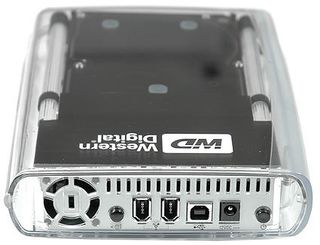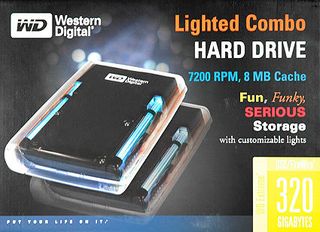Western Digital Goes Flashy With Lighted Hard Drive
The Staid Hard Drive By Daytime

The technical details are very much up to date. Obviously, Western Digital deploys its own 320 GB UltraATA hard drive; the WD3200JB runs at 7,200 RPM and offers an 8.9 ms read seek time. This translates into an effective access time of 13.3 to 13.5 ms, depending on whether you use USB 2.0 or Firewire. Both interfaces are available - USB 2.0 supports up to 480 Mbit/s while Firewire, aka IEEE-1394a, supports up to 400 Mbit/s. However, you cannot use both at the same time.
Once again Firewire proves to be the clearly more efficient protocol, as it hits a transfer rate of almost 40 MB/s reading and 28 MB/s writing, while the USB 2.0 interface stays below 32 MB/s reading and 29 MB/s writing.
These numbers reflect the maximum data transfer rate the device is able to read or write sequentially, without any file system. After formatting with FAT32 or NTFS, the effective performance will always be considerably lower. Yet the raw performance numbers are the best way to compare different products.
In fact, it is the interface that is slowing down the performance of external hard drives. Firewire 1394b, with its 800 Mbit/s transfer speed, is one possible workaround. However, there are not too many drives out there that support it, and controllers are also a bit more expensive than 1394a models. External SATA (eSATA) is eventually going to open this bottleneck by enabling external drives using the SATA interface, with performance of 150 or 300 MB/s.



Stay on the Cutting Edge
Join the experts who read Tom's Hardware for the inside track on enthusiast PC tech news — and have for over 25 years. We'll send breaking news and in-depth reviews of CPUs, GPUs, AI, maker hardware and more straight to your inbox.
Current page: The Staid Hard Drive By Daytime
Prev Page WD Lighted Combo Drive In The (Spot)-Light Next Page ... Turns Into A Colorful Display By NighttimeMost Popular

